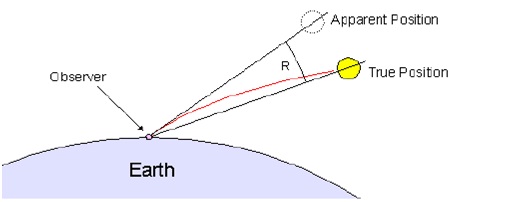If the earth’s surface were an infinite plane, visible and sensible horizon would be identical. In reality, the visible horizon appears several arcminutes below the sensible horizon which is the result of two contrary effects, the curvature of the earth’s surface and atmospheric refraction.
The geometrical horizon, a flat cone, is formed by an infinite number of straight lines tangent to the earth and radiating from the observer’s eye.
Since atmospheric refraction bends light rays passing along the earth’s surface toward the earth, all points on the geometric horizon appear to be elevated, and thus form the visible horizon. If the earth had no atmosphere, the visible horizon would coincide with the geometrical horizon.
Note:
The correction for dip has to be omitted (dip = 0) if any kind of an artificial horizon is used since an artificial horizon indicates the sensible horizon.
The altitude obtained after applying corrections for index error and dip is also referred to as apparent altitude.
You may also know about atmospheric refraction:
A light ray coming from a celestial body is slightly deflected toward the earth when passing obliquely through the atmosphere. This phenomenon is called refraction, and occurs always when light enters matter of different density at an angle smaller than 90°.
Since the eye cannot detect the curvature of the light ray, the body appears to be at the end of a straight line tangent to the light ray at the observer’s eye and thus appears to be higher in the sky. R is the angular distance between apparent and true position of the body at the observer’s eye.




Leave a Comment